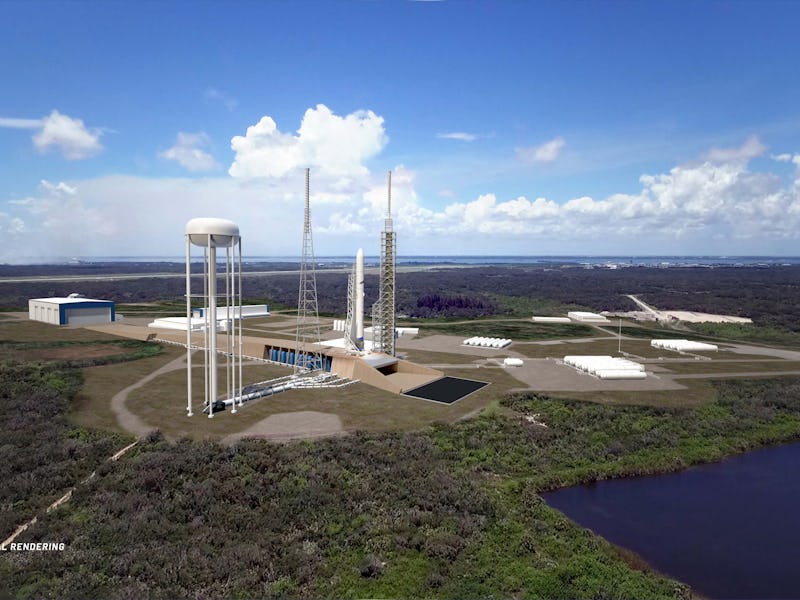Blue Origin New Glenn: Specs, power, and updated launch window for giant rocket
Blue Origin is planning to launch the New Glenn rocket to orbit. Here's what you need to know about it.

Blue Origin’s first crewed flights have made headlines for expanding the potential of space tourism — but its plans for an even more powerful rocket could transform it into a key player in the broader spaceflight industry.
The Jeff Bezos-founded firm has so far launched three crewed capsules to just above 62 miles altitude, internationally recognized as the “Karman line” boundary of space.
While the flights have attracted criticism as a display of billionaires taking needless trips into space for a few minutes, Blue Origin plans to use the technology from the rocket to develop a more powerful rocket.
The larger rocket is called New Glenn. It was first unveiled in September 2016, with the goal of sending crew and cargo to orbit, whereas the New Shepard isn’t capable of reaching orbit. Progress with New Shepard is expected to help build New Glenn.
“There’s quite a bit of technology transfer from New Shepard to New Glenn,” Jarett Jones, head of the New Glenn program, said during the livestream of Blue Origin’s first crewed launch.
The rocket could send satellites that help people on Earth, like those for internet access and weather tracking. It all starts with New Glenn — but thanks to recent delays, it could take some time.
Want to find out more about the emergent new space race and competitors like SpaceX and Blue Origin? Subscribe to MUSK READS+ for exclusive interviews and analysis about spaceflight, electric cars, and more.
New Glenn deploying its payload.
Blue Origin New Glenn: what does the name mean?
New Glenn is named after NASA astronaut John Glenn. In 1962 he became the third American to go to space as one of the “Mercury Seven” astronauts. The mission also made him the first American to orbit the Earth.
Blue Origin also named its smaller New Shepard rocket, designed for suborbital space tourism, after NASA astronaut Alan Shepard. He became the first American in space back in 1961, and in 1971 he became the first person to hit a golf ball on the Moon.
In 1998, at the age of 77, John Glenn set the record as the oldest person to go to space when he launched aboard the Discovery space shuttle. Ironically, Blue Origin beat this record on July 20 when it launched the first crewed New Shepard mission with 82-year-old Wally Funk on board.
Blue Origin New Glenn: what are the specs?
New Glenn is big. The first stage measures 57.5 meters (188.5 feet), and the second stage 23.4 meters (76.9 feet). The whole vehicle measures 96 meters tall (313 feet), with a tank diameter of seven meters (23 feet).
New Glenn in the lineup.
The first stage has seven BE-4 engines, powered by liquid oxygen and liquefied natural gas. These produce 3.85 million pounds of thrust at sea level.
The second stage uses two BE-3U engines to produce 240,000 pounds of thrust in a vacuum. It uses liquid oxygen and hydrogen as its fuel.
New Glenn's flights in action.
Blue Origin claims the rocket can launch 45 metric tons (99,208 pounds) to low-Earth orbit and 13 metric tons (28,660 pounds) to geostationary transfer orbit.
An artist's impression of New Glenn at the launchpad.
Blue Origin New Glenn: How does it compare to SpaceX Falcon 9?
The Falcon 9 is SpaceX's most-used rocket. It has powered 124 of the company’s 132 launches, including its three crewed missions.
The Falcon 9 measures 70 meters tall (229 feet) with a diameter of 3.66 meters (12 feet). The first stage uses nine Merlin engines to offer 1.7 million pounds of thrust at liftoff. The second stage uses one MVac engine to offer 220,500 pounds of thrust in a vacuum.
The rocket can carry 22,800 kg (50,265 pounds) to low-Earth orbit and 8,300 kg (18,300 pounds) to geostationary transfer orbit.
New Glenn is clearly bigger and more powerful, but it’s important to remember that SpaceX also offers a three-core variant called the Falcon Heavy. With a total of 27 Merlin engines delivering 3.1 million pounds of thrust at liftoff, it can send 63,800 kg (140,660 pounds) to low-Earth orbit and 26,700 kg (58.860 pounds) to geostationary transfer orbit.
That’s before you get to the under-development Starship, capable of sending over 100 tons (220,000 pounds) to low-Earth orbit.
New Glenn's BE-4 engine.
It’s important to note that, like Falcon 9, New Glenn will launch from Cape Canaveral in Florida. But where SpaceX uses Launch Complex 39A and Space Launch Complex 40 for its missions, Blue Origin plans to use Launch Complex 36 for its New Glenn missions.
This will be a marked difference from New Shepard, which conducts its launches from west Texas.
Blue Origin New Glenn: when will it launch?
The big question. At the 2016 unveiling, the firm expected to launch it before the end of the decade. In February 2021, Blue Origin announced that it pushed the launch back from late 2021 to the fourth quarter of 2022. This delay, Blue Origin explained at the time, was because it missed out on key Pentagon contracts that were instead awarded to SpaceX and ULA.
But at the Satellite 2022 trade convention, held in Washington, D.C. from March 22 to 24, Jones revealed that the rocket would not launch this year.
The BE-4 engine from New Glenn will also power United Launch Alliance’s Vulcan Centaur rocket. The engine is expected to be delivered this year ahead of Vulcan’s first flight. At the Satellite 2022 event, United Launch Alliance CEO Tory Bruno declared that the engine is “running beautifully” and it is undergoing testing at Blue Origin around three times per week.
SUBSCRIBE TO MUSK READS+, A PREMIUM NEWSLETTER COVERING THE WORLDS OF ELON MUSK, SPACEX, TESLA, AND EVERYTHING BETWEEN.
This article was originally published on